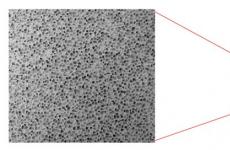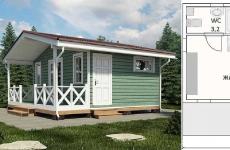Standard sizes of doorways, calculation rules for purchase. Standard dimensions of interior doors with and without a frame What are the dimensions of interior doors with a frame
The first thing you need to pay attention to when buying interior or metal doors is their size. Its choice depends on the purpose of the structure and the existing opening in which it will be installed. In this case, not only the dimensions of the canvas, but also the door frame are important.
Standard dimensions of interior doors
Domestic and foreign manufacturers offer many different sizes of interior doors. The most common widths are:
- 600 mm;
- 700 mm;
- 800 mm.
However, on sale there are doors whose width differs from accepted standards. So, you can see canvases in 50 and 55 cm.
For sliding and double leaf doors, the width of the door will be larger. It can be from 90 centimeters to 1 meter 80 centimeters. Doors of the big sizes are made to order.
The standard door leaf height is:
- 2 meters;
- 2 meters 30 centimeters.

But you can often find doors 1 meter 90 centimeters in height, as well as 2 meters 10 centimeters and 2 meters 20 centimeters.
Standard sizes of metal doors
Entrance metal doors are considered an emergency exit, so they are subject to certain requirements regarding dimensions. They are set out in SNiP and GOST. But their implementation in the manufacture of doors is not necessary, therefore, deviations up or down are possible.

The width of steel entrance doors cannot be less than:
- 80 cm in private houses and apartments;
- 120 cm in rooms where the number of people exceeds 15 people.
The height of metal doors must be at least 1 meter 90 centimeters. Standard indicators, as for interior doors, are:

- 2 meters;
- 2 meters 30 centimeters.
By individual order, non-standard metal doors can be made. Their height and width will correspond to the size of the opening. But this will affect the weight of the structure, and, consequently, the load on the walls. Therefore, it is necessary to increase the dimensions of the metal door, taking into account these features.
Width and height of door with frame
Usually doors and a frame for them are sold as a set. They fit true to size and won't cause problems when installed.
The width of the door together with the frame depends on the width of the leaf:
- for a canvas of 800 mm it will be 87 cm;
- for a canvas of 700 mm, the width with a box will be 77 cm;
- the value for a 600 mm door will be 67 cm.
When calculating, regardless of the size of the canvas 550, 600, 700 or 800 mm, the size of the gaps between the box and the door is taken into account, which will be the same everywhere. It is equal to 6-8 millimeters, on each side 3-4 millimeters.

The standard height of the door with the frame will also depend on the height of the door leaf:
- with a value of 2 meters, it will be 2 meters and 7 centimeters;
- with a value of 2 meters 30 centimeters, it will be 2 meters and 37 centimeters.
The calculations take into account the dimensions of the gaps and the threshold. The gap is a constant value, it does not depend on the height of the door.

The threshold height must be considered for entrance and interior doors installed at the entrance to the bathrooms. For other doors, there must be a gap between the floor and the leaf. It is 15-20 mm for kitchen doors if liquefied gas is used in the house and 5-10 mm in all other cases. The horizontal gap in the upper part of the door, like the vertical ones, is 3-4 mm.

The thickness of the door frame can vary from 15 to 45 mm depending on the material and manufacturer. This indicator should be sufficient to ensure reliable fastening and operation of the door.
Purpose of the door depending on the size
The size of the door largely depends on its purpose. A width of 50, 60, 70 or 80 centimeters depends on the room at the entrance to which it will be installed.

The door is 50 cm wide and very narrow. It is usually placed at the entrance to utility rooms, such as a pantry or dressing room. For interior doors, 50 centimeters is too narrow a passage. It will not be enough for the free movement and movement of furniture. Therefore, they are made wider than 50 centimeters.
The door, whose width is 600 millimeters, is suitable for installation in the bathroom and toilet in small apartments. It can also be installed at the entrance to the kitchen.
The canvas, the size of which is 70 centimeters wide, is used to separate bedrooms, offices and other rooms. 70 cm is usually enough to comfortably move around the apartment. This width allows you to carry furniture and other items that are large. Sometimes you can find interior doors 80 centimeters wide.

The opening at the entrance to the living room is wide enough. Single and double doors or sliding systems are often placed in it, the width of which can be 90 centimeters or more. However, in small apartments, the opening to the living room can be small, designed for a door of 700 or 800 mm.
Being engaged in repair or construction, think in advance what size the entrance metal and interior doors will be. Making an opening for standard widths of 600, 700, 800 mm or more and heights of 2 and 2.3 m, you do not have to redo the opening or make doors to order.
An attractive design of a room or a separate room can be created thanks to the correct selection of all components. The quality and style of the wallpaper, doors, flooring, windows and ceiling make for a great end result. The door leaf should be the first element that will create the overall design.
As well as door leafs differ in the material of which the product consists.
For painting
If the repair budget is small and you want to focus on the quality of the door leaf, a good option would be primed door. Ideal for painting. It is a frame made of wooden bars, covered with MDF sheets.

A fairly common example - doors for painting from solid pine. It is often used to make high quality blanks. Therefore, this option can be safely called one of the best among cheap types. The advantage of such products is the many colors that you can choose for the interior door.

Laminated
These door leafs differ from all other types in their structure. They are made quite simply and efficiently. MDF sheets are attached to the wooden frame and decorated with a special laminate. This is a professional artificial coating. It is designed to extend the life of doors and protect them from the harmful effects of the environment.
- paper based
- From several layers of paper with special impregnation
- Laminate is a patterned paper impregnated with synthetic resin and bonded to a non-woven backing.

PVC coated
Such products differ from the previous top layer. Polyvinyl chloride or simply plastic film is waterproof and wear-resistant. This allows you to install products in rooms with high humidity, for example, in a bathroom. The coating does not require special care, is resistant to mechanical stress, does not fade in the sun.

Enamel
Products from MDF or wood are covered with enamel. The advantage of painted doors is that they do not require special care, are easily restored, and are affordable. Recently, doors with patina or painting have gained popularity.

Veneered
The door leaf, covered with veneer, consists of a frame, a filler and a facing layer. Two types of construction are popular: from MDF panels (economical option) and solid wood (more expensive). Veneer is a thin slice of natural wood with a thickness of 0.1–10 mm. It is made using special carpentry equipment, and then tightly attached to the base to decorate the surface. Typically, veneer is made from precious wood, the texture of which gives the interior presentability.

Ecoveneer
Eco-veneer coating is an artificial material that allows you to accurately copy the pattern of valuable wood species. Only repeating patterns on the canvas give out a synthetic origin. Products are resistant to a wide range of temperatures and humidity. Such a surface is difficult to scratch, it can withstand light impacts. Artificial material is glued to the canvas so that there is no edge. With such a production technology, the possibility of detachment from the base is excluded.

From solid wood
The array is more expensive, but adds nobility to the interior of any room. It is easy to mount, and the design is quite resistant to external influences. Their wide distribution is limited by high cost, otherwise the products are more durable than synthetic counterparts. For production, wood of oak, ash, beech, alder, larch and pine is mainly used.

glass
Stylish and beautiful products are becoming more popular every year. They are quite durable and resistant to high temperatures and high humidity. Glass moisture resistant doors are perfectly combined with any other materials. For the decoration of such canvases, spraying, stained glass painting, a combination of frosted and transparent glasses are used.

metal-plastic
A variety of metal-plastic canvases has become more widespread in exterior or balcony types of doors. Less often they are used as interroom. Although, such varieties serve for quite a long time.

Standard sizes
When choosing products, it is important to take into account all dimensions - the height, width and thickness of the door leaf. Only having decided on the dimensions of the opening, you can stop your choice on a specific option.
In order to make it easier to decide on a model, you can resort to the simplest method - use the standard sizes of door panels. In most cases, these indicators are the same for many types of structures. For the room - 800 mm, for the bathroom and bath - 600 mm and for the kitchen 700 mm.
These are standard indicators that are used everywhere. Of course, width the door leaf may differ, since many doors are adjusted to certain sizes of the opening itself. Many manufacturers have canvases of the following sizes: 400 mm, 600 mm, 700 mm, 800 mm, 900 mm. Less common are 450 mm, 500 mm.

Sizes of leaf and opening for swing doors
In second place in importance is the following indicator - height canvases. If in the case of a width there are many options, then when choosing a height, the list is smaller. The fact is that 1900 and 2000 mm are generally accepted door standards. Based on this, it should be noted that the best choice of height is always standard door sizes.
Thickness door leaf of interior doors is 40 mm. This is quite enough to ensure a solid and stable structure. And also the allowable values are 36 and 38 mm.
On the market or in a specialized store, you can buy both one canvas and all the components: a box, platbands and extensions. The second option is better, since the color of the coating may vary in different batches.
For non-standard openings
Product selection does not always mean that the end result will be standard. Sometimes the conditions in an apartment or house, as well as their own ideas, force the owners to change the dimensional data to more convenient indicators. The door leaf in this case is selected according to the desired size of the opening.
Production of non-standard doors is quite common. These products can be ordered from almost any company. It is necessary to take measurements in advance. This is critical because the parameters must be met as much as possible. Most often, canvases are made to order, which differ from the standard ones in height.

The use of products of non-standard size is relevant in large rooms. For example, many owners of country houses order huge double doors, which are equipped at the entrance to the hall.
Repair is a rather time-consuming process that requires attention and a responsible approach. You can achieve a high-quality desired result by following a certain algorithm of actions. Finishing the floor and walls is preceded by the installation of interior doors. The standard sizes of doorways should be calculated carefully, otherwise buying doors can turn into a frustration.
During installation, special attention should be paid to the opening: its dimensions, configuration, and a number of other parameters. It is necessary to determine the dimensions in advance in order to avoid undesirable situations when you have to order non-standard doors or engage in additional wall decoration. In this case, the interior door and the repair as a whole will cost the owner of the dwelling much more than it could have been.
Today, manufacturers offer a huge number of their most diverse variations. Most of them have standard sizes:
— door height is 200 cm;
- width can be 60 cm, 70 cm or 80 cm.
A number of manufacturers present products with a width of 550 mm and a height of 1,900 mm. Not only the specified parameters vary, but also the width of the box - from 15 mm to 45 mm.
If these parameters are neglected, a situation may arise in which the box simply does not fit, which will entail additional monetary costs. The presence of any engineering communications, plasterboard partitions with a metal frame will also complicate the expansion process.
The situation will be reversed when the opening is too large for the door. The narrowing will entail the need to apply to construction organizations and additional costs.
Structural components required for calculations
Calculation of the dimensions of the interior door
- the height of the desired canvas, its width;
- thickness and width of the door frame;
- the width of the platbands;
- the presence and size of the threshold.
Example of calculating door dimensions: height and width
An example is the following calculation. The size of the desired door leaf is 2,000*800mm, and the thickness of the door frame is 25mm. You can calculate the size of the required opening by adding the thickness of the box to the width. The last indicator takes place on both sides, so the thickness of the box is added twice. The calculation should also take into account the necessary mounting clearances, which are approximately 15-20 mm on each side. The formula for calculating dimensions is the following sum:
800+25+25+15+15=880 (mm)

Opening with box in section
A width of 800 mm is almost ideal for most interior door manufacturers. These doors can be easily installed in standard sizes of residential doorways.
The height is calculated in the same way, based on the presence of a threshold and mounting clearances. To do this, the thickness of the box, the size of the gap (10-20 mm) is added to the height of the canvas.
The total height is:
2000+25+10+15=2050 (mm)
For a door leaf, the dimensions of which are 200 * 80 cm, the opening in the wall must have dimensions of 2050 * 880 mm.

Height detection
Doorway thickness
In addition to width and height, the opening is characterized by thickness. In typical houses, the standard is 75 mm. Manufacturers of interior doors offer the consumer door frames of the same thickness. If these measures are not taken, the subsequent installation of platbands can be problematic, leading to an unattractive appearance of the door.
To determine the wall parameter, it is recommended to measure its thickness at three (at least) points on all sides. With the same parameters around the perimeter of the entire opening, you will have to order a non-standard door. If the thickness at these points differs, then you will have to cut the box, and in some cases put an extension. Unequal thickness indicates the curvature of the wall. If you do not take the necessary measures, then it will not be possible to qualitatively install platbands.
Currently there are certain standards. A competent approach to measuring parameters, calculating the optimal dimensions, taking into account the dimensions of the desired door leaf, a number of other nuances - all this allows for a high-quality and reliable installation of a door that will last more than one year. It will delight the owners of the house and their guests not only with its functionality and safety, but also with its aesthetic appearance, which is largely achieved with proper installation.
Did you calculate the dimensions correctly? Watch a video on door selection based on style, material characteristics and operating conditions.
To properly install the door in the house, you first need to calculate its dimensions. It should be noted that the standard dimensions of doorways are clearly regulated by GOST and SNiP. This approach avoids confusion when designing private houses and multi-storey buildings. At the same time, the parameters of the entrance and interior canvases are selected based on the convenience and intensity of their operation.
Of course, when building a house, standards may not be adhered to, since they are more of a recommendation than a mandatory one. However, compliance with the approved dimensions has its advantages:
- Big choice. Almost all manufacturers produce door structures of standardized sizes. Therefore, you can easily select the best door for a particular case.
- Budget savings. Buying a non-standard canvas will cost you 30-50% more, because an individual order provides for additional labor costs in the manufacture of the product.
- Easy installation. The closer the size of the doorway to the standard, the easier it will be to seal the mounting seams.
Standard sizes of interior doors and openings
It is good if the openings for internal and entrance doors have standard dimensions, since in this case the installation work will not take you much time and effort. If the place for installing the door frame is atypical, then you can get out of this situation in two ways:

- make an individual order, significantly increasing the cost of the structure;
- adjust the dimensions to the existing GOSTs.
In the second case, you will either need to expand the hole in the wall, which is not always possible due to the specific design of the apartment, or puzzle over how and how to close the doorway so that it is both reliable and attractive.
The dimensions of interior and entrance doors consist of two parameters: the dimensions of the opening and the door leaf itself. At the same time, the standards of domestic and foreign companies are different. Although these differences are small, they can significantly complicate the installation of doors. Most domestic companies in the production of single-leaf interior doors are guided by the following standards: leaf height - 200 or 230 cm, width - 80 or 90 cm, box thickness - 7.5 cm. In this case, the size of the opening in length and width should be 5-10 more cm, which is due to the presence of wooden or metal and assembly seams.
If the width of the opening is 110 cm or more, then it is recommended to make a double-leaf door, in which one part will be movable and the other deaf.

The standard width of such structures is (in cm):
- 30+80;
- 40+80;
- 50+90;
- 90+90.
Double-leaf products are often installed in offices, mansions and cottages. In terms of strength, they are in no way inferior to single-leaf, of course, if purchased from trusted manufacturers.
The dimensions of the door leaf also depend on where it will be installed:
- for bathrooms in small apartments, doors 55 cm wide are usually used;
- for kitchens - 70 cm;
- for bedrooms and children's rooms - 80 or 90 cm.

The thickness of the interior structure is no less important than the height and width, since the sound insulation and strength of the canvas directly depend on it. The thickness of the door can be as follows (in mm):
- standard - 35-40;
- hinged - 20-40;
- from a wooden array with a sample of 1/4 - 35-45;
- from pure wood - 45-55.
Entrance door dimensions
Such a concept as the standard size of the entrance opening is losing its relevance every year. This is especially true for private houses, in the construction of which standardization is increasingly receding into the background.

- if an ordinary wooden product is mounted, then the dimensions will be 204x82.5 cm;
- for metal structures - 205x86 (96) cm;
- for double-leaf products - 200 (205) x160 cm.
How to calculate the dimensions of the doors yourself?
Before you go to the store and buy an entrance or interior door, you need to calculate its dimensions: width, height and thickness. If you have a doorway, then everything is quite simple. To calculate the width of the future canvas, you first need to measure the width of the opening at least at three points (bottom, middle and top). After that, assembly seams (10 mm on each side), the width of the loot and the gap between the canvas itself and the jamb (about 5 mm) are subtracted from the smallest value. The height of the doorway is considered similarly.

To calculate the thickness of the box, you will need to measure the thickness of the wall at three points, and then choose the largest value from the results obtained.
Today, almost all firms involved in the production of entrance and interior doors are trying to standardize the dimensions of their products in accordance with established standards. This must be taken into account when building a private house, since a properly planned building will allow you to install standard canvases, thereby saving a significant amount of money on an individual order.
You have decided on the color of the interior door and the type of construction, but do not know what size is right for you? Do not rush to buy, first determine the size of your doorways. From our article you will find out what sizes of interior doors are considered standard and how to correctly measure the doorway so that later it would not be excruciatingly painful for the time and money spent.
Standard dimensions of interior doors
Most manufacturers adhere to the standard dimensions of interior doors: height 2000, width 600 mm, 700 mm, 800 mm. More rare doors with a size of 1900 mm * 550 mm can also be considered a standard. The size takes into account only the door leaf, boxes and platbands are considered separately. These dimensions are optimally suited for GOST doorways.Recall that different types of premises have their own size standards:
To the kitchen: web width - 700 mm, web height - 2000 mm, opening depth - 70 mm.
To the bathroom: web width - 550 mm or 600 mm, web height - 1900 mm or 2000 mm, opening depth - from 50 mm to 70 mm.
To the rooms: web width - 800 mm, web height - 2000 mm, opening depth - from 70 mm to 20 mm.
However, the dimensions of the openings are not always standard. In this case, either the opening is changed, or the door is made to order. Making a door to order is 30% more expensive than a similar but standard model.
How to correctly calculate the size of the opening for an interior door?
Even if you are sure that all the openings in your house are standard, still measure. Walls may not be perfect. In order to find out the optimal door dimensions for your room, you need to know the following parameters:1. Dimensions of the doorway. We measure the width and height at three points and fix the smallest value.
2. The thickness of the door frame. We measure at three points and fix the largest value. Standard size 70 mm.
3. Width of architraves . The width of the architraves is important if a large gap forms between the doorway and the frame.
4. The presence and size of the threshold. The threshold is made from a part of the box and corresponds to its thickness.
5. Availability of extras . If, when measuring the thickness of the door, you realized that your size is far from standard, then you will need extras. The extensions of almost all manufacturers have a standard width - 100 mm, 150 mm, 200 mm.
So, we took all the necessary dimensions and we can proceed to the calculations. Let's say we want to install an interior door measuring 2000mm * 800mm with a frame thickness of 25mm. Then we will do the following calculation:
Calculation of the width of the opening for an interior door
800 mm ( web width) + (25 + 25) mm ( box) + (20 + 20) mm ( mounting clearance) + 5 mm ( total gap for free entry of the web into the box ) = 895 mm.
Calculation of the opening height for an interior door
2000 mm ( web height) + 25 mm ( box thickness) + 25 mm ( gap between floor and door or threshold ) + 20 mm (mounting gap at the top ) + 3 mm ( for free door entry into the box ) = 2075 mm.
We round up the values and get that for a door with a size of 2000mm * 800mm with a frame thickness of 25 mm, we need an opening of 2080mm * 900mm.
Non-standard sizes of openings require narrowing or widening. When expanding the opening, depending on the material of the wall, either cutting the opening or cutting is used. Cutting is required for monolithic walls, cutting is suitable for blocks and bricks. The narrowing of the opening is carried out using brickwork or concreting.






